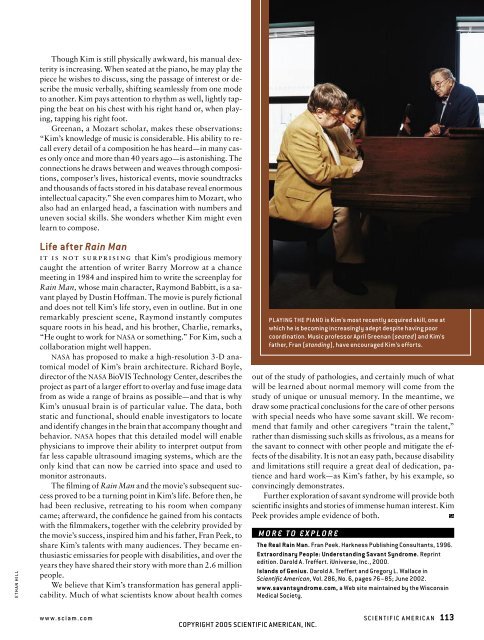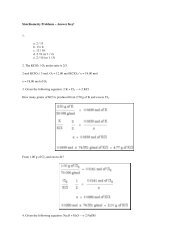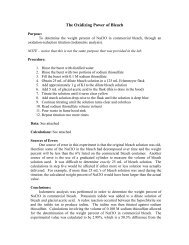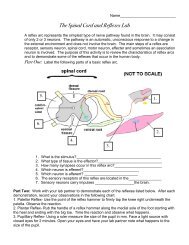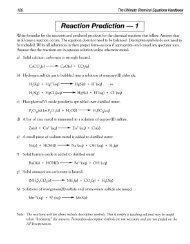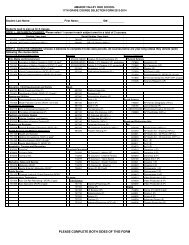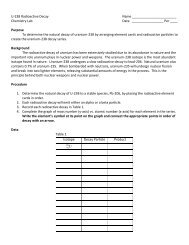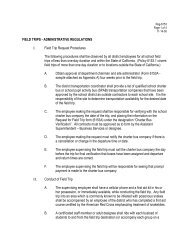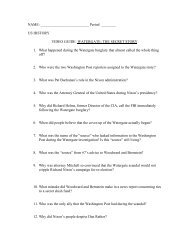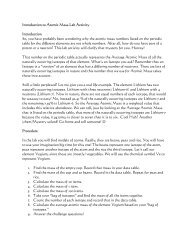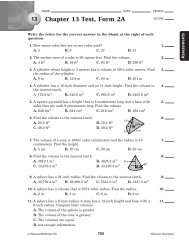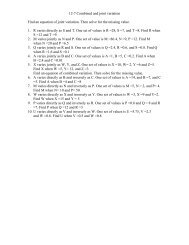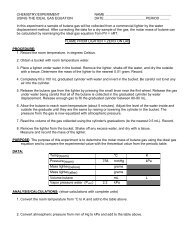Inside the Mind of a Savant
Inside the Mind of a Savant
Inside the Mind of a Savant
Create successful ePaper yourself
Turn your PDF publications into a flip-book with our unique Google optimized e-Paper software.
E T H A N H I L L<br />
Though Kim is still physically awkward, his manual dexterity<br />
is increasing. When seated at <strong>the</strong> piano, he may play <strong>the</strong><br />
piece he wishes to discuss, sing <strong>the</strong> passage <strong>of</strong> interest or describe<br />
<strong>the</strong> music verbally, shifting seamlessly from one mode<br />
to ano<strong>the</strong>r. Kim pays attention to rhythm as well, lightly tapping<br />
<strong>the</strong> beat on his chest with his right hand or, when playing,<br />
tapping his right foot.<br />
Greenan, a Mozart scholar, makes <strong>the</strong>se observations:<br />
“Kim’s knowledge <strong>of</strong> music is considerable. His ability to recall<br />
every detail <strong>of</strong> a composition he has heard—in many cases<br />
only once and more than 40 years ago—is astonishing. The<br />
connections he draws between and weaves through compositions,<br />
composer’s lives, historical events, movie soundtracks<br />
and thousands <strong>of</strong> facts stored in his database reveal enormous<br />
intellectual capacity.” She even compares him to Mozart, who<br />
also had an enlarged head, a fascination with numbers and<br />
uneven social skills. She wonders whe<strong>the</strong>r Kim might even<br />
learn to compose.<br />
Life after Rain Man<br />
i t is no t su r pr isi ng that Kim’s prodigious memory<br />
caught <strong>the</strong> attention <strong>of</strong> writer Barry Morrow at a chance<br />
meeting in 1984 and inspired him to write <strong>the</strong> screenplay for<br />
Rain Man, whose main character, Raymond Babbitt, is a savant<br />
played by Dustin H<strong>of</strong>fman. The movie is purely fictional<br />
and does not tell Kim’s life story, even in outline. But in one<br />
remarkably prescient scene, Raymond instantly computes<br />
square roots in his head, and his bro<strong>the</strong>r, Charlie, remarks,<br />
“He ought to work for NASA or something.” For Kim, such a<br />
collaboration might well happen.<br />
NASA has proposed to make a high-resolution 3-D anatomical<br />
model <strong>of</strong> Kim’s brain architecture. Richard Boyle,<br />
director <strong>of</strong> <strong>the</strong> NASA BioVIS Technology Center, describes <strong>the</strong><br />
project as part <strong>of</strong> a larger effort to overlay and fuse image data<br />
from as wide a range <strong>of</strong> brains as possible—and that is why<br />
Kim’s unusual brain is <strong>of</strong> particular value. The data, both<br />
static and functional, should enable investigators to locate<br />
and identify changes in <strong>the</strong> brain that accompany thought and<br />
behavior. NASA hopes that this detailed model will enable<br />
physicians to improve <strong>the</strong>ir ability to interpret output from<br />
far less capable ultrasound imaging systems, which are <strong>the</strong><br />
only kind that can now be carried into space and used to<br />
monitor astronauts.<br />
The filming <strong>of</strong> Rain Man and <strong>the</strong> movie’s subsequent success<br />
proved to be a turning point in Kim’s life. Before <strong>the</strong>n, he<br />
had been reclusive, retreating to his room when company<br />
came; afterward, <strong>the</strong> confidence he gained from his contacts<br />
with <strong>the</strong> filmmakers, toge<strong>the</strong>r with <strong>the</strong> celebrity provided by<br />
<strong>the</strong> movie’s success, inspired him and his fa<strong>the</strong>r, Fran Peek, to<br />
share Kim’s talents with many audiences. They became enthusiastic<br />
emissaries for people with disabilities, and over <strong>the</strong><br />
years <strong>the</strong>y have shared <strong>the</strong>ir story with more than 2.6 million<br />
people.<br />
We believe that Kim’s transformation has general applicability.<br />
Much <strong>of</strong> what scientists know about health comes<br />
PL AYING THE PIANO is Kim’s most recently acquired skill, one at<br />
which he is becoming increasingly adept despite having poor<br />
coordination. Music pr<strong>of</strong>essor April Greenan (seated) and Kim’s<br />
fa<strong>the</strong>r, Fran (standing), have encouraged Kim’s efforts.<br />
out <strong>of</strong> <strong>the</strong> study <strong>of</strong> pathologies, and certainly much <strong>of</strong> what<br />
will be learned about normal memory will come from <strong>the</strong><br />
study <strong>of</strong> unique or unusual memory. In <strong>the</strong> meantime, we<br />
draw some practical conclusions for <strong>the</strong> care <strong>of</strong> o<strong>the</strong>r persons<br />
with special needs who have some savant skill. We recommend<br />
that family and o<strong>the</strong>r caregivers “train <strong>the</strong> talent,”<br />
ra<strong>the</strong>r than dismissing such skills as frivolous, as a means for<br />
<strong>the</strong> savant to connect with o<strong>the</strong>r people and mitigate <strong>the</strong> effects<br />
<strong>of</strong> <strong>the</strong> disability. It is not an easy path, because disability<br />
and limitations still require a great deal <strong>of</strong> dedication, patience<br />
and hard work—as Kim’s fa<strong>the</strong>r, by his example, so<br />
convincingly demonstrates.<br />
Fur<strong>the</strong>r exploration <strong>of</strong> savant syndrome will provide both<br />
scientific insights and stories <strong>of</strong> immense human interest. Kim<br />
Peek provides ample evidence <strong>of</strong> both.<br />
M O R E T O E X P L O R E<br />
The Real Rain Man. Fran Peek. Harkness Publishing Consultants, 1996.<br />
Extraordinary People: Understanding <strong>Savant</strong> Syndrome. Reprint<br />
edition. Darold A. Treffert. iUniverse, Inc., 2000.<br />
Islands <strong>of</strong> Genius. Darold A. Treffert and Gregory L. Wallace in<br />
Scientific American, Vol. 286, No. 6, pages 76–85; June 2002.<br />
www.savantsyndrome.com, a Web site maintained by <strong>the</strong> Wisconsin<br />
Medical Society.<br />
w w w. s c i a m . c o m S C I E N T I F I C A M E R I C A N 113<br />
COPYRIGHT 2005 SCIENTIFIC AMERICAN, INC.


